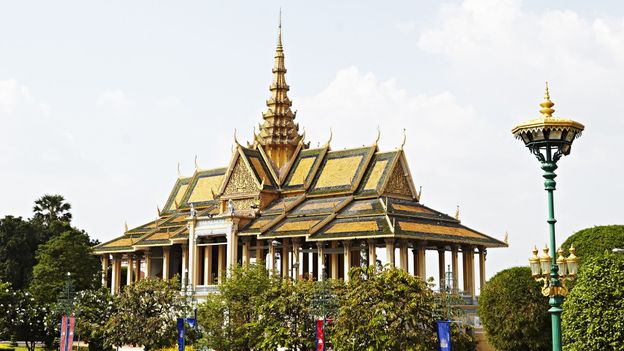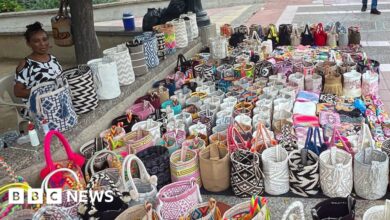The perfect trip: Cambodia


From ancient temples to an elegant capital and all the rich village life in between, Cambodia is a small country with a big soul where family and religion reign supreme.
Marvel at
the palaces, markets and bars of the capital, Phnom Penh, before heading north
to Siem Reap for excursions to a floating village on Tonlé Sap Lake and the
extravagant, inspirational temples of Angkor. From there, it is south to the
untouched jungles of the Cardamom Mountains, finishing with a homestay on a
rural family farm.
Phnom Penh: Best for culture
Phnom Penh is
eerily quiet. A sole remork – the usually ubiquitous motorised rickshaw – rolls
languorously past the Royal Palace to a deserted Tonlé Sap riverfront. Here,
among the shuttered-up shops facing the palm-lined promenade, food stalls sell
noodle soup and beef skewers to infrequent customers.
The peace
doesn’t last. As the Khmer festival that emptied the city ends, Phnom Penhois
who’d been drawn to rural family gatherings in their tens of thousands flood
back to the capital and the beguiling chaos resumes. After a troubled history,
which reached its nadir with the Khmer Rouge’s enforced eviction of the city in
the ’70s, the ‘Pearl of Asia’ is thriving, with a flourishing café culture and
a glut of world-class fusion restaurants.
Prosperity
has added an extra sheen to its cultural institutions too, many of which were
built during Cambodia’s French Protectorate era, beginning in 1863. Among these
is the Art Deco Psar Thmei, a pastel-yellow covered market with four wings
radiating from an enormous central dome.
A few hours
after dawn and the Central Market, as it is also known, is already a blur of
browsing and bartering. Business is brisk at textile stalls selling traditional
checked krama scarves, while elsewhere chattering shoppers weave past fruit
outlets piled with lychees and crimson dragon fruit, and stalls overflowing
with lotus flowers and bunches of fragrant Rumdul, Cambodia’s national flower.
Just a few
blocks from the market, the National Museum is close enough to the riverfront
to receive some of its welcome breeze. A group of schoolchildren in matching
white polo shirts and flip-flops plays in the shade of the terracotta building’s
neatly tended garden while, inside, visitors reflect upon 1,000 years of Khmer
sculpture.
The
adjacent Royal Palace, with its glistening spires and dragon-tail details,
still dominates the city’s low-rise skyline. In a corner of one of its courtyards,
a team of artists is working to restore a 1901 mural of the Reamker –
Cambodia’s version of the epic Hindu poem the Ramayana.
‘When I did classical painting at university,
we studied the Ramayana,’ says lead artist Roeung Sreyna, gesturing to the mural
behind her, where spirits and horse-drawn chariots float over a celestial
palace in the sky.
The project is slow and technical. Matching
the colours takes time, as does cleaning stains and fixing damage from
humidity. ‘We take one section at a time,’ she says, pointing at a
three-foot-wide band. ‘Two months for each section, and we have to work slowly.
If it were a normal painting, we could do it in a year, but this is our
history, so we have to take care.’
Tonlé Sap: Best for lake life
In the village of
Me Chrey, the streets are made of water and the wooden houses float. The
village’s 500 families are among the thousands who have settled on the surface
of the freshwater Tonlé Sap, Cambodia’s ‘Great Lake’, where, not surprisingly,
life revolves around the water. As dawn breaks, Me Chrey is already abuzz.
Toddlers paddle small aluminium tubs down the main street, fruit and vegetable
sellers in bright floral clothing and conical hats navigate boats between
houses, and householders check for breaches in ‘fish banks’ – submerged reed
baskets where fish are kept until market day. Shouted greetings and lively
chatter are punctuated by the occasional snort of a pig from a floating pen.
Further out on the water, a family retrieves traps and nets laid out in wide, intricate
arrangements.
It’s an
itinerant existence. The floating houses, which are tied to one another, are
moved by the villagers four times a year to follow migrating fish stocks. The
lake’s wildly fluctuating dimensions also a play a part – in the rainy season,
Tonlé Sap swells to more than 6,000 square miles, raising the floating houses
by around eight metres. Dry season sees the potential spots to anchor reduced
significantly.
Sok Ang has
lived in the village for more than 30 years. Four years ago she opened up a
shop, connected to the family’s one-room home, which she runs while her husband
and children do the fishing. Today, however, the kids sit behind with some
neighbours, watching a soap opera on a TV connected to a car battery – the main
source of power in the village. The shop sells all the necessities, from
shampoo to cooking oil as well as lotus-seed snacks. ‘I sell whisky, too, but
beer is more popular around here – especially Klang beer, which means strong,’
says Sok, laughing. The shop doesn’t have a name – at least not officially.
‘Everyone calls it Yeay [Grandma] Ang’s shop. I don’t have grandkids, but the
village calls me that.’
Me Chrey is
one of the less visited of Tonlé Sap’s villages and seeing it by kayak is the
most atmospheric way to experience it. There is none of the noise or fuss of a
regular tour boat, allowing the visitor to glide past a clump of water hyacinth
and observe a gaggle of black-and-white mynah birds cavorting undisturbed. The
sedate, unmotorised pace is also more in tune with village life. Following
guide Chin on a meandering tour of the back streets, a wooden boat squeezes
past in a narrow channel. It’s powered by a small girl, with equally diminutive
oars. From the back, her baby sister waves excitedly. Children look up from
swinging hammocks to note the kayaks’ silent passing.
Paddling a kayak is easy, but not effortless;
the perfect refreshment comes in the form of a strong, sweet iced coffee served
by a mother and daughter in a covered boat that is part coffee shop, part
convenience store. Competition for Grandma Ang – but here, in this remote,
placid, water world, it’s no surprise to learn that cooperation holds sway.
‘The whole village are friends,’ says Grandma Ang. ‘I know everyone. If a
family has a celebration, we all go to help out. Same if someone is sick – if
one family has a fast boat, they’ll bring them to the mainland. We all have
each other.’
Angkor: Best for temples
It’s late afternoon
in an incense-filled hall in Angkor Wat. A tough-looking teenager in sunglasses
and ripped jeans approaches an altar. On woven plastic mats, women pray to a
Buddha statue, barely visible through the thick jasmine smoke. A fortune teller
earnestly reads Jataka tales – stories of the Buddha’s former lives – and from
the surrounding cloisters, lined with smaller, standing and seated Buddhas
draped in saffron silks and fresh garlands, the sound of distant chanting
echoes. The teenager takes off his trainers, carefully placing them next to the
women’s flip-flops, and silently puts his hands together to join the group in
prayer.
Angkor Wat
is the world’s largest religious structure, an architectural representation of
the Hindu universe and the undoubted star of a massive temple city built, over
the course of 600 years, by dozens of rulers who considered themselves part
god, part king. Known today, rather prosaically, as Angkor Archaeological Park,
the 150-square-mile site was the political and cultural centre of the Khmer
empire and at its peak supported a population of one million.
The temples
are still active centres of faith and everyday life today. Among the tourists
who cross Angkor Wat’s sandstone causeways to explore its warren of chambers,
courtyards and covered galleries are ranks of the devout. The Gallery of 1,000
Buddhas is now bereft of the vast majority of its eponymous statues – a legacy
of the brutally destructive Khmer Rouge era of the early ’70s. Yet its
spiritual significance remains undimmed.
As evening
approaches, sunlight inches across the gallery’s courtyard to probe the dim
cool of the covered walkways. Here, bas-reliefs of apsara dancers and pillars
enlivened with Sanskrit inscriptions celebrating good deeds take on a rosy hue.
The source of the chanting is revealed to be the Hall of Echoes, on the
northern side of the gallery. As newly crowned Khmer kings once did, a group of
young boys is harnessing the unusual acoustics here by pounding their chests, a
process thought to offer mental and physical purification.
The walled
and moated city of Angkor Thom sits about a mile due north of Angkor Wat. The
most common approach to this sprawling complex, built by King Jayavarman VII as
a statement of power in the late 12th century, is the stone-figurelined causeway
to the crumbling South Gate. Despite its graceful, moss-swathed decay, the gate
is undeniably imposing, its four giant bodhisattva faces staring beatifically
out. Disturbed by a passing motorcycle rickshaw, a macaque pokes it head from
beneath the arch to observe the scene, before retreating nonchalantly into the
shade.
At the
exact centre of the city stands the enigmatic Bayon – the state temple of
Jayavarman. Built nearly a century after Angkor Wat, its 54 stone towers are
carved with more than 200 huge faces; their resemblance to the famously
hubristic king is not thought to be coincidental. A Buddhist altar is tucked
away in a dark tower of Bayon; outside, rocks thought to create curses if
removed are piled in small, thoughtful arrangements.
At Ta
Prohm, to the northeast of Angkor Wat, strangler figs spill like liquid over 39
temples in various stages of ruination, creating a tangle of tipsy roofs and
dark hallways. Inside one temple, an altar of Shiva, replete with gold-foil
decorations and offerings of mangoes and Sprite, is tended by a ‘wat granny’ –
the term for older women, often widows, who have taken monastic vows and help
maintain religious buildings between meditation and prayer. She whispers
blessings into a string bracelet before attaching it to the wrist of a devotee.
Monastic
communities continue to live throughout Angkor, with Buddhist monks often
passing through the historic sites on their way to and from their pagodas (a
blend of temple and monastery). Tao Lav is 18 years old and joined Ta Prohm
Meanjay, a pagoda outside Ta Prohm, earlier in the year. ‘When I became a monk,
it wasn’t difficult – just a little bit boring,’ he says, laughing. ‘The first
few days, I missed my family and friends, but the longer I stay, the more I
give up, and now I’m happy.’
He lives in
a simple thatched hut and is one of only five monks at the humble pagoda, and
also the youngest. ‘This is a good pagoda. There aren’t many monks or noise, so
it’s easy to meditate. And this is a heritage area, so the government doesn’t
allow it to get built up. It’s very peaceful. Now that I’ve learned how to
meditate, I like doing it. I feel so fresh afterwards. I’m trying to meditate
more and more – no more thinking about the outside world.’
Cardamom Mountains: Best for jungle
The early-monsoon
rains are falling hard in the Cardamom Mountains, perforating the glassy
surface of the Tatai River. Lightning cuts through the slate-blue sky, scaring
off the fireflies that usually dance over the water at dusk. The forested foothills
darken, as the leaves of thousands of palm trees twist and turn restlessly in
the downpour.
When the
rain finally eases, steam starts to rise off the river’s surface, and frogs
emerge from their hiding spots to plop around, experimenting with the new water
levels. Mist slides lazily along the surrounding hills, meandering through
coconut palms, wild-plum trees and pendulous jackfruits. The Tatai Waterfall is
for the first time this year rushing over boulders, the moss that clings to
them now a little greener. Local boys backflip from the rocks, yelling as they
drop into the swollen pools.
This richly
verdant pocket of southwest Cambodia is an area of protected forests and
conservation corridors. What really preserves it, though, is its
impenetrability – a dense web of jungle canopies enveloping a smattering of
small villages and, latterly, eco-resorts. No surprise that the Cardamom
Mountains was one of the last strongholds of the Khmer Rouge, with militants
hiding out here for nearly two decades after the regime’s barbarous heyday in
the late ’70s.
Hand-cleared
paths linking isolated villages now serve as trekking routes for those looking
to explore a less familiar side of the country. One such link, between the
villages of Takat and Tuleki, clearly serves as a major thoroughfare. ‘The
trails became well worn,’ says guide Ravy, Vy for short, ‘because those two
villages are good friends.’
Red, white
and black crabs emerge to bathe in puddles, while a troop of long-tailed
macaques flits through the trees with a cacophany of screeching. On damp logs,
mushrooms flourish. One type of these is used in spring rolls, another in mice
poison. ‘Luckily, they look very different,’ says Vy.
Leaves that
will later be used to wrap sticky rice are glistening, and an ‘ant house’ – a
tiny, box-shaped nest made of leaves – has been dislodged by droplets and lies
on the ground. Villagers will employ this in traditional medicine. Little goes
to waste in such a remote and bountiful environment.
Midway
along the path, a woman and her two sons emerge from the jungle carrying
weathered shopping baskets full of wild mushrooms. Other days they might
contain frogs. ‘When it rains, we go out in the early morning with a torch to
get them,’ says Vy. He does the same with durian in season. ‘They fall in the
night, so I come out at 5am before anyone else can take them.’
Back at the
Tatai River, the sky is putting on a show of pinks and violets, while monsoon
clouds churn in the distance. Birds start to shift and sing, and the forest
rustles with the sounds of animals heading out on their evening rounds – and
villagers returning home with firewood.
Takeo province: Best for rural life
When Siphen Meas
was growing up in the ’80s, her family lived off the land. Like most
Cambodians, they’d lost their property and savings during the four-year rule of
the Khmer Rouge that ended in 1979. Unlike many, they’d escaped with their
lives. ‘We didn’t go shopping. We found our own fruit and grew our own
vegetables,’ she says. ‘After school I’d pick greens to eat, fish in the lake
or go to the bush to get firewood.’
Today,
Siphen and her family shop all the time – nearby Angk Tasoam market is a
favourite – but they still work the land in their village of Prey Theat, around
two hours south of Phnom Penh. And it provides generously, producing rice,
taro, coconut and mango. She now runs a homestay with her husband Mach, a
fellow English teacher. Their house is surrounded by paddy fields, in which
ducks frolic under the irate gaze of yoked oxen, as children wobble past on
oversized bicycles. A neighbour harvests snails and small fish from a paddy
field using a woven-basket scoop, stopping to pass the time of day with a
family on a scooter – two children sandwiched uncomplainingly between their
parents on the slender seat.
Rice season
is July to December, and everyone pitches in – even homestay guests. ‘They work
hard,’ says Siphen with a smile, ‘and the villagers laugh and say, “Why do they
want to work like that?”.’
The homestay
is a focal point of the village, many members of which are related to Siphen
and Mach – Siphen hazards a guess that they have 100 family members in Prey
Theat. Guests become part of the family too, staying in bungalows in the
fruit-tree-laden grounds or in wood-panelled rooms in the main house. The
peaceful, hammock-strewn courtyard is the centre of family life – a place for
cousins to chat, braid one another’s hair and catch up on village gossip.
Siphen’s
kitchen is also outdoors, lending the preparation of meals a communal feel.
With the early evening sunlight dancing off the lily pond at the back of the
homestay, Siphen lays out pork ribs, fish amok (fish curry steamed in banana
leaves) and beef lok lak (beef stir-fried with red onions), before calling over
Mach from his task of trimming the grass around the fruit trees.
Assisting
her with the cooking are young pupils from the small school next door, who sing
Cambodian pop songs as they chop vegetables. Their English is excellent and
they chat excitedly with the native speakers at the homestay, some of whom will
head to their classroom in the morning to join a class and offer some impromptu
language tutoring.
The meal
ends with a mango dessert – the family property is home to seven different
kinds of the fruit, which Siphen’s niece picks using an ingenious tool made
from a plastic bottle and long stick.
The homestay really is a family effort. ‘Even
the distant cousins are close,’ explains Siphen. ‘Everyone looks after one
another. Many people were lost from our family during the Khmer Rouge’s rule.
So we all feel cold in our hearts and want to be closer to each other.’
Source link




